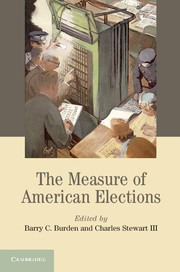Book contents
- Frontmatter
- Contents
- List of figures
- List of tables
- List of contributors
- Acknowledgments
- 1 Introduction to the Measure of American Elections
- 2 Registration and Voting: A View from the Top
- 3 Voter Registration: The Process and Quality of Lists
- 4 Provisional Ballots
- 5 Mail Ballots in the United States: Policy Choice and Administrative Challenges
- 6 Voting from Abroad: Evaluating UOCAVA Voting
- 7 Polling Place Practices and the Voting Experience
- 8 Disability and Election Policies and Practices
- 9 The Performance of Election Machines and the Decline of Residual Votes in the United States
- 10 Voter Confidence as a Metric of Election Performance
- 11 Election Data Transparency
- Appendix
- References
- Index
1 - Introduction to the Measure of American Elections
Published online by Cambridge University Press: 05 August 2014
- Frontmatter
- Contents
- List of figures
- List of tables
- List of contributors
- Acknowledgments
- 1 Introduction to the Measure of American Elections
- 2 Registration and Voting: A View from the Top
- 3 Voter Registration: The Process and Quality of Lists
- 4 Provisional Ballots
- 5 Mail Ballots in the United States: Policy Choice and Administrative Challenges
- 6 Voting from Abroad: Evaluating UOCAVA Voting
- 7 Polling Place Practices and the Voting Experience
- 8 Disability and Election Policies and Practices
- 9 The Performance of Election Machines and the Decline of Residual Votes in the United States
- 10 Voter Confidence as a Metric of Election Performance
- 11 Election Data Transparency
- Appendix
- References
- Index
Summary
How good are American elections?
Where would one start in answering this question?
Whenever this question is posed, it is common to answer it from the position of deeply held beliefs, but rarely from the position of a systematic analysis of facts. These beliefs might arise from partisanship: a good election is one that my favored candidate wins. These beliefs might be chauvinistic: a good election is one run according to the rules of my community.
Rarely are these beliefs rooted in hard facts.
When facts intervene, they rarely are presented in a systematic fashion. Opinions about levels of voter fraud might be attributable to a viral YouTube video. Concerns about the effects of a new voter identification law might be informed by a reporter’s interview with an activist who is eager to share stories about how voters she has talked with will be disenfranchised on Election Day. Satisfaction with a new electronic voting machine may be illustrated by a picture of a smiling citizen coming out of the precinct with an “I Voted” sticker stuck to her lapel. Disdain about the ability of local governments to run elections might follow from a newspaper article detailing yet another season of long lines when waiting to vote in Florida (or South Carolina or Maryland or …). At its worst, this approach is evaluation by anecdote.
- Type
- Chapter
- Information
- The Measure of American Elections , pp. 1 - 39Publisher: Cambridge University PressPrint publication year: 2014
- 4
- Cited by

